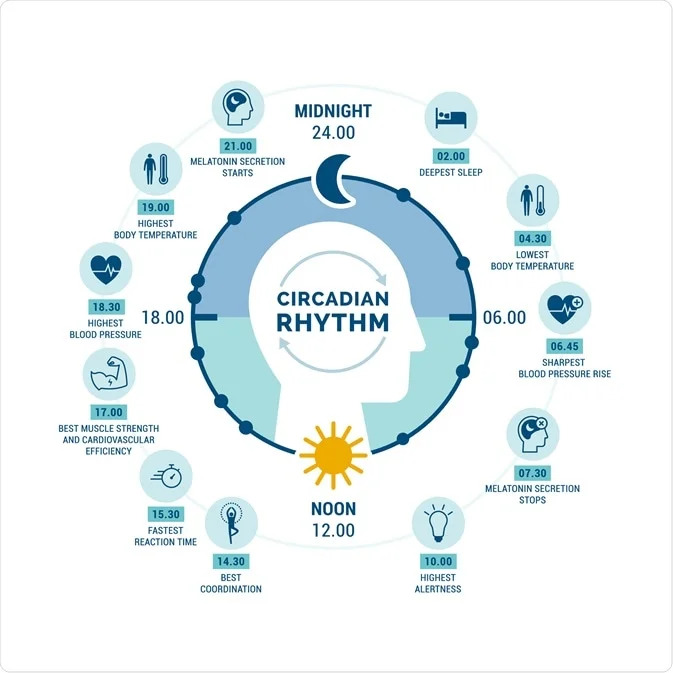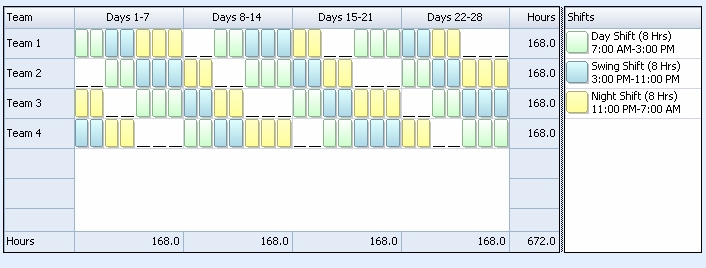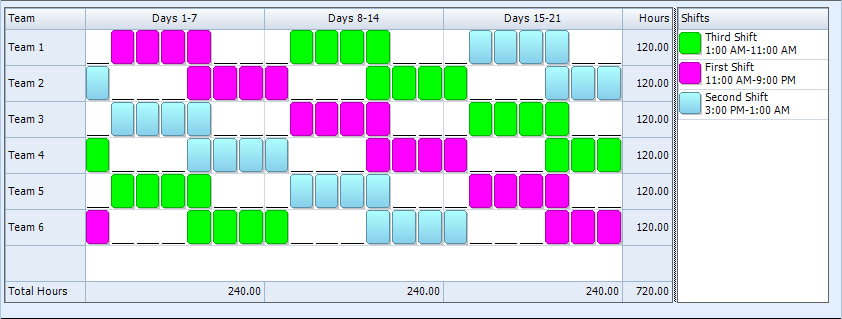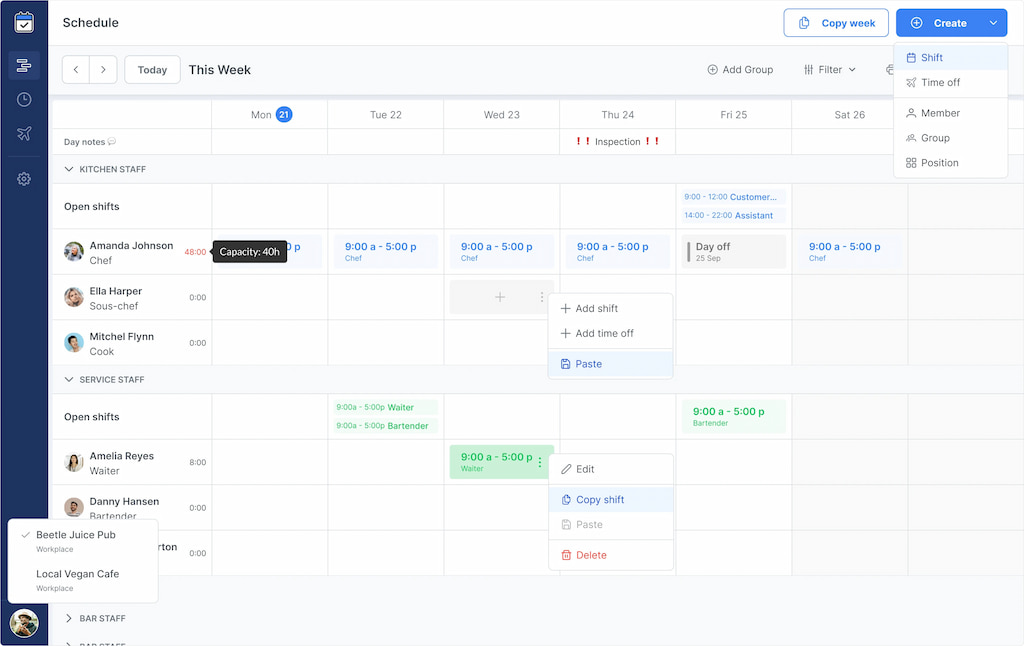Free employee shift scheduling apps can make managing rotating shifts much simpler. Rotating shifts are becoming more common in the modern workplace, so both employers and employees need to know how to schedule shifts. But what is a rotating shift, exactly? Rotating shifts are scheduled shifts that change over time. The work schedules change, meaning employees work different shifts at varying times of the day, week, or month. For example, a retail worker may work three weeks of day shifts followed by three weeks of night shifts.
However, like any scheduling model, rotating schedules come with their own set of benefits and drawbacks. This article will explore rotating shifts, including their benefits, drawbacks, the most common types of rotating schedules, and rotating work shift implementation strategies.
Definition of a Rotating Shift
Rotating shifts are work schedules that change from one shift to another over time, on a rotating basis.
Specific shifts include day, evening, and night shifts. In most cases, all employees cover each shift type throughout the week or month.
Shifts vary but are usually somewhere between 8 and 12 hours long. Employers tend to distribute shifts evenly, with all employees working various shifts in a given time period. As businesses strive to offer better customer experiences, rotating schedules have become a key aspect of workforce management.
Rotating shift calendars, sometimes called turning schedules, allow organizations and workers of all kinds, including retail, hospitality, IT services, firefighters, police, and hospitals, to operate efficiently across opening hours. Let’s explore the importance of these types of schedules with a rotating shift example. In the case of emergency services, 24-hour coverage is required, making rotational shifts one of the most suitable scheduling options.
What are the Benefits of Rotating Shifts?
Increased coverage and continuous operation

Rotating shifts are an excellent solution for organizations that require constant coverage, such as healthcare centers and manufacturing companies. These shifts ensure that critical operations operate around the clock, ensuring that customer service is not interrupted. For these organizations, interrupted coverage could have dire consequences.
You can take care of rotating shifts in hospitals via the best healthcare scheduling software systems like Shifts by Everhour.
Fair distribution of favorable and challenging shifts
One of the main benefits of a rotating shift system is that it ensures an equal distribution of shifts among employees. As employees alternate between various shifts, including day and night shifts, everyone gets their fair share of what they perceive as favorable and less favorable shifts.
This is a considerably fairer way to distribute shifts, instead of giving some employees the ‘bad’ shifts and others the ‘good’ ones, which may look like favoritism.
As a result, rotating shifts minimize the potential for resentment or dissatisfaction, which could occur in those who regularly have unfavorable or challenging shifts.
Flexibility for employees with personal commitments
Another benefit of rotating shifts is flexibility, allowing employees to balance their work with personal commitments. For instance, a parent may prefer day shifts that closely align with school hours to spend more time with their children, whereas students prefer evening hours as it is less disruptive to their studies. The flexible nature of rotating schedules can improve job satisfaction and reduce staff turnover as a result.
Enhanced employee engagement and job satisfaction
A well-structured rotating schedule can enhance job satisfaction and employee engagement. The varying shifts can help to reduce boredom and keep employees engaged in the process, which boosts overall morale. Furthermore, exposing all employees to a range of shifts can help to create a better team, as all members learn to appreciate the challenges of various roles and shift schedules.
Opportunities for skill development and cross-training
Rotation shifts can also provide opportunities for skill development and cross-training with other employees. As employees are exposed to different shifts and roles, they can better understand the inner workings of business and enhance their skill set by effectively shadowing another team member. This comes in particularly handy if a crisis occurs where workers may be expected to take on different roles to ensure provision for customers and clients.
What are the Drawbacks of Rotating Shifts?
Disruption of circadian rhythm and health implications
Rotating shifts can disrupt the circadian rhythm, a 24-hour cycle that controls sleep-wake cycles, digestion, and the release of hormones. This can have several health implications for workers. The most common health issues experienced by workers on rotating shift schedules are sleep disorders. The inconsistent nature of rotating shifts disrupts the body’s internal clock, which can result in insomnia. Over time, sleep deprivation can become chronic and significantly negatively impacts mood, cognitive function, and overall life satisfaction.

Rotating shifts (for example, NOC shifts) have also been associated with stress, as the irregular nature of shifts can disrupt how the body manages stress. This may lead to other problems, such as anxiety and depression. These mental health conditions impact almost all aspects of employees’ lives.
Challenges maintaining work-life balance
Unfortunately, rotating shifts can have a negative impact on work-life balance. The lack of a consistent routine, which provides structure and some predictability, makes it hard for rotating shift workers to plan personal activities, exercise, social events, and hobbies, which inevitably leads to stress and burnout.
Potential impact on social life and relationships
The unpredictable nature of rotating shifts impacts workers’ social lives and relationships. Employees at the mercy of rotating shift schedules often find that their off-peak hours don’t coincide with their family and friends, who likely follow more conventional schedules such as 9 to 5. This time mismatch significantly reduces opportunities for socialization, which can negatively impact family life and mental well-being.
For example, a study of nurses working rotating shifts found that 83.3% of respondents reported a perception of negative family engagement. The irregular nature of rotating shifts makes it difficult for employees to commit to their family and social arrangements, which may lead to feelings of isolation.
Increased risk of fatigue and decreased productivity
Rotating shifts can make fatigue in employees more likely, which has a knock-on effect in decreasing productivity, as fatigue can affect proper cognitive function. Reduced cognitive function has several negative effects, including more workplace errors and accidents.
Common Types of Rotating Shifts
There are several common rotating shift types to consider implementing, including:
Fixed pattern
Fixed pattern rotating shifts have employees moving between day, evening, and night shifts according to a fixed schedule. The schedule could be created and distributed weekly or monthly. For example, an employee could work day shifts for two weeks, followed by two weeks of evening shifts. The main benefit of this shift type is its predictability, but only if employees know their shift patterns well in advance.
Slow rotation

Slow rotation shifts have employees working a specific shift for longer before the next shift rotation, which could last several weeks or months. While these shift types are less disruptive to sleeping patterns, employees may struggle to readjust when shift changes finally occur.
Fast rotation

Fast rotation shifts frequently see employees moving between different shift types, usually every few days. An example is an employee working day shifts for three days, evening shifts for three days, and night shifts for three days before repeating the shift cycle. This shift type can be incredibly disruptive to the body’s circadian rhythm, as it does not allow for adjustment to work and sleeping patterns, which can lead to stress and mental and/or physical illness.
Continental shifts

Continental shifts, sometimes known as four on, four off’ shifts, provide 24/7 coverage using four teams and two 12-hour shifts. Each team works three or four consecutive days or nights, then has one or two days off to rest and recharge before restarting the cycle.
DuPont

The DuPont shift schedule is a fast rotating shift arrangement that uses four teams and two 12-hour shifts to provide 24/7 coverage, with a cycle that runs for 28 days. Each team works a sequence of day and night shifts and days odd to ensure provision. However, teams get a 7-day break every 28 days. This schedule type depends because it includes four-night and three-day shifts in a row, which may be challenging for employees to handle. However, the 7-day break provides some time for employees to rest and recharge. This rotating shift schedule is commonly used in industries where complete coverage is essential, such as emergency services.
Pitman

Like the DuPont schedule, the Pitman schedule uses four teams and two 12-hour shifts to ensure 24/7 coverage. Over periods of four weeks, each team has 14 days off. The 4-week long repeat cycle includes sequences of two or three consecutive night and day shifts and days off. This rotating shift schedule can benefit employees as it provides regular time off and every other weekend off work, meaning they can make concrete plans with family and friends.
24-48

The 24-48 shit schedule is commonplace in emergency services, as it uses three teams working 24-hour shifts, followed by 48 hours off work. This rotating shift schedule allows 24/7 coverage with the same number of teams working daily. The 48-hour time-off gives employees recovery time before they have to work again. Regardless, this shift pattern can be incredibly mentally and physically demanding due to the 24-hour-long shift times.
4-3

The 4-3 rotating shift schedule involves employees working four consecutive 10-hour shifts followed by three days off, allowing 24/7 coverage across four teams. Each team follows this sequence: four-day shifts, three days off, four-night shifts, and three days off. This schedule is beneficial as employees work the same amount of hours each day they’re at work but get more days off than 9 to 5 workers. This can positively impact work-life balance, as employees have more time to spend with loved ones and on their hobbies and interests.
Implementing Rotating Shifts
So, how do you make a rotating schedule? When it comes to implementing rotating shifts, there are several steps you should take to increase the chances of success:
Considerations for effective shift rotation planning
When planning a rotating shift schedule, you must consider the specific requirements of your organization, employees’ strongest skills, and, of course, labor laws for your country. You may benefit from using software tools to create a balanced and fair rotation schedule that meets all the necessary requirements, such as Shifts by Everhour.

The tool simplifies the rotating shift scheduling process by allowing you to schedule shifts anywhere, anytime (as long as you’ve got an internet connection). Set up workplaces if you operate across different locations, add as many employees as you need, and organize teams into groups. With Shifts by Everhour, you can manage rotating shift schedules with ease. When scheduling is done right, productivity increases and labor costs are reduced, resulting in a better bottom line.
Communication and transparency with employees
Transparent communication is essential. Explaining the reasoning behind the rotating shifts you’re putting in place, establishing clear guidelines, and setting up accessible feedback mechanisms are crucial if implementation is to be a success.
Addressing employee preferences and concerns
Employees may have concerns about specific rotating shift schedules. To ensure the process goes smoothly, ask employees for feedback and encourage them to raise any concerns they have. Also, be willing to make changes to accommodate reasonable change requests or risk low job satisfaction, burnout, low employee retention, and high turnover!
Strategies for minimizing the negative effects of rotating schedules
Providing sufficient rest periods, creating a positive work environment, setting up accessible feedback channels, and offering health and wellness resources are key to a successful rotating shift implementation. Employees need to feel heard and supported; otherwise, they’ll consider looking for work elsewhere.
Tips for Adjusting to Rotating Shifts
Adjusting to rotating shifts can be challenging for employees. Here are steps they can take to make the transition more manageable:
Establishing a consistent sleep routine

It’s vital to establish a consistent sleep routine. Employees may find sleep aids such as blackout curtains and fans to induce sleep and avoid caffeine in the afternoons and evenings to promote better sleep quality.
Prioritizing self-care and maintaining a healthy lifestyle
Regular physical activity, socialization with family and friends, time for hobbies and interests, and a balanced diet are essential components of a healthy lifestyle. They should also prioritize self-care (which looks slightly different to everyone) to promote better sleep, improve their mood and boost their health.
Optimizing the work environment for shift workers

Make the transition easier for employees by optimizing the workforce conditions: offering healthy meals and snacks and quiet and comfortable spaces for breaks where employees can relax before going back to work.
Seeking social support and building a support network
Employees working rotational shifts benefit from strong support networks to combat the challenges of their jobs. Employees should connect with other shift workers, keep in contact with family and friends and seek professional support if they are struggling.
Managing stress and coping with shift work challenges
Stress quickly leads to burnout, which leads to reduced productivity, and in some cases, mental health problems. Employees can reduce stress by prioritizing mindfulness, meditation, and regular exercise. If problems occur or they start to feel overwhelmed, employees should seek support from their managers, who may be able to make adjustments.
Legal and Safety Considerations
When implementing rotating shifts, organizations must take legal and safety considerations into account, including:
Compliance with labor laws and regulations
It is essential to adhere to all relevant local and national laws regarding working hours, breaks, overtime, and minimum wage. Failure to do so will mean organizations quickly find themselves in hot water. Neglecting these requirements could result in legal penalties and irreparable reputational and employee morale damage.
Addressing safety concerns and mitigating risks
Another key consideration when implementing rotating shifts is safety. As we’ve discussed, rotating shift work can damage employees’ health, increasing the likelihood of workplace accidents. To mitigate safety risks, employers should enforce regular breaks, ensure the workplace has optimal temperature and lighting, provide healthy food options, and encourage employees to make the most of workplace health and wellness programs.
Final Thoughts: The Impact of Rotating Shifts
Let’s recap. So, what is a rotating shift? A rotating shift is a system where employees work various shifts over a period, allowing businesses to function continuously. Rotating shifts, sometimes known as rotating rosters, have potential drawbacks despite offering numerous benefits such as 24/7 coverage, employee flexibility, and cross-training opportunities. The disruption to health, work-life balance, and decreased productivity are harmful to employees and the organizations they work for, so steps should be taken to reduce the negative impact of rotating shift schedules.
What do rotating shifts mean for businesses and their employees? Managing them effectively requires careful thought and application of staggered work schedules and a clear understanding of employees’ needs and preferences. It’s all about striking a balance where businesses benefit from continuous operation while employees work schedules that support their health and personal commitments.
Ultimately, a well-managed rotating work shift schedule can foster a high-performing and engaged workforce that meets the demands of organizations requiring 24/7 provision. The rotating shift definition goes way beyond the schedule itself, it’s about effectively managing people, including their health and productivity, to create a functioning work environment.
If you’re looking for a seamless way to improve shift planning, Shifts by Everhour is the perfect solution (for example, as the best cleaning company scheduling software). With features like real-time monitoring, easy scheduling, and mobile accessibility, managing your workforce has never been simpler.

